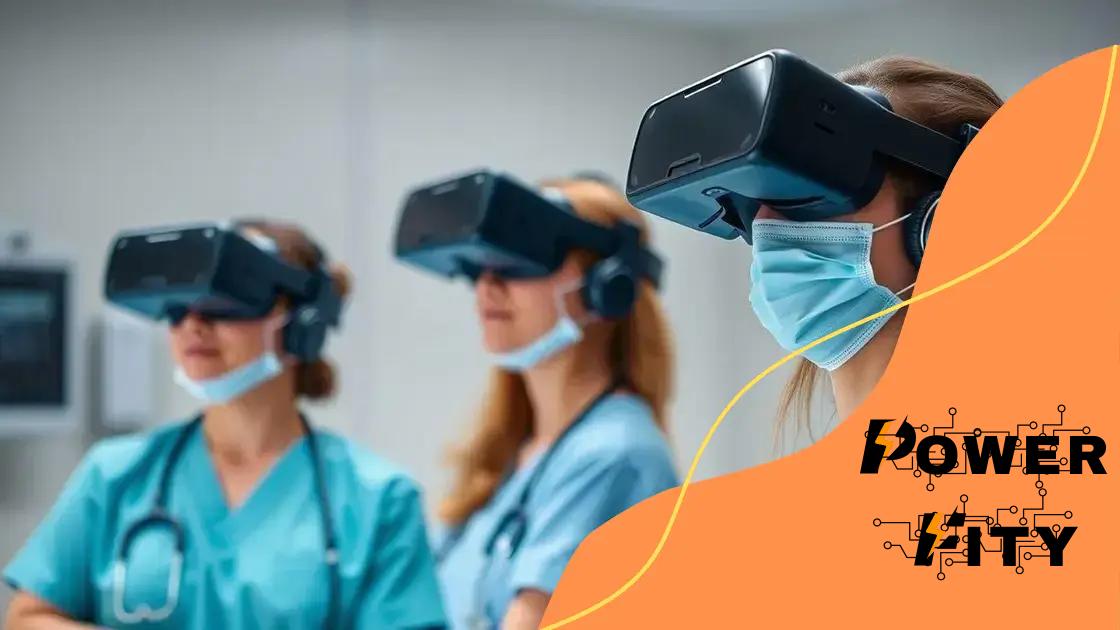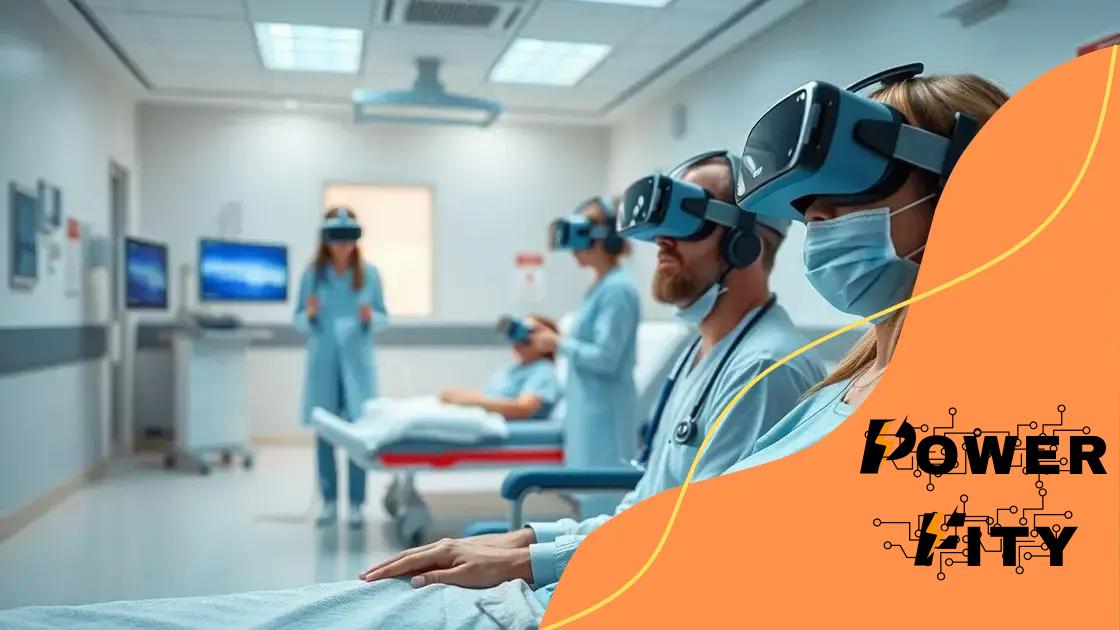Virtual reality in training medical professionals: transforming education

Virtual reality in training medical professionals enhances skill development through realistic simulations, allows personalized learning experiences with AI integration, and prepares healthcare providers for real-world challenges effectively.
Virtual reality in training medical professionals is changing the way future healthcare providers learn their skills. Imagine being able to practice complex surgeries in a risk-free environment, enhancing knowledge and confidence. Curious about how this technology is shaping medical education? Let’s dive in.
The impact of virtual reality on medical training
The use of virtual reality (VR) in medical training is revolutionizing education for healthcare professionals. With its ability to create immersive, realistic simulations, VR helps students develop essential skills in a safe environment.
Enhanced Skill Development
Through VR, medical students can practice procedures repeatedly without the fear of causing harm. This level of practice is crucial for mastering complex techniques. For example, a student can perform virtual surgeries, practicing on lifelike anatomy without any risk.
Realistic Scenarios and Immediate Feedback
One of the most significant advantages of VR training is its capacity to mimic real-life scenarios. Students feel as if they are in a real operation room. They can receive immediate feedback on their performance, which helps them identify areas of improvement quickly.
- Safe environment for learning
- Improvement of decision-making skills
- Ability to practice rare procedures
This type of training is not just about performing tasks. It also aids in enhancing critical thinking and problem-solving skills required in medical emergencies. Engaging with virtual patients allows students to understand and react to various conditions they might face.
Emotional Preparedness
Another impact of VR on medical training is the emotional preparedness it fosters. Students can experience high-stress situations, learning how to manage their anxiety and perform under pressure. Feeling the intensity of a critical situation helps build the necessary resilience.
As technology continues to evolve, the potential for virtual reality in medical training becomes more apparent. Institutions are increasingly adopting these technologies, recognizing their benefits in enhancing education.
Benefits of immersive simulations for healthcare professionals
Immersive simulations offer a transformative approach to training for healthcare professionals. By engaging in these realistic environments, they gain valuable experience that traditional training cannot provide.
Real-world Experience
One of the key benefits of immersive simulations is the ability to practice in real-world scenarios without the risks. Healthcare professionals can encounter emergency situations, learn to make quick decisions, and experience patient interactions—all in a virtual setting.
Improved Retention and Skills
Studies show that learning through experience significantly enhances knowledge retention. Professionals who use immersive simulations tend to remember procedures better. They can also refine their skills more effectively, which is crucial when it comes to patient care.
- Safe practice environment
- Immediate feedback on performance
- Opportunities to repeat scenarios
Another advantage is the chance for teamwork in a simulated environment. In these scenarios, professionals can collaborate with others, improving their communication skills and understanding of roles within a healthcare team. This collaboration mirrors real-life situations where teamwork is essential.
Enhanced Confidence and Competence
Participating in immersive simulations can boost confidence. When healthcare professionals repeatedly practice their skills, they feel more prepared for actual situations. This readiness enhances their competence, ensuring that they can respond effectively to patient needs.
As healthcare continues to evolve, utilizing immersive simulations will become increasingly important. These tools not only prepare professionals for the challenges they might face but also improve overall healthcare quality.
Real-world applications of virtual reality in hospitals

The application of virtual reality (VR) in hospitals is changing the landscape of healthcare. By integrating VR technology, medical facilities improve training, treatment, and patient care.
Training Medical Staff
In many hospitals, VR is utilized for training medical staff in various procedures. This technology allows staff to practice surgeries and diagnostics in a risk-free environment. They can engage with realistic patient simulations, gaining confidence and refining their skills.
Patient Treatment and Rehabilitation
VR is also making waves in patient treatment, especially for rehabilitation. Patients recovering from injuries can participate in immersive physical therapy sessions. These sessions are designed to motivate patients and make rehabilitation more engaging.
- Improved mobility in post-surgery patients
- Reduced anxiety during treatments
- Enhanced patient participation in recovery
Another significant application is in pain management. Hospitals use VR to help patients manage pain during procedures, allowing them to focus on immersive experiences instead of discomfort. This can significantly reduce the reliance on medication.
Enhancing Patient Experience
Beyond training and treatment, hospitals are incorporating VR to enhance the overall patient experience. Virtual reality can help distract patients from stressful environments, such as waiting rooms or during long procedures. This use of VR has shown to improve patient satisfaction and reduce anxiety levels.
As technology evolves, the potential for virtual reality in hospitals will expand, presenting new opportunities for improving healthcare outcomes. The focus will be on continuing to innovate how healthcare is delivered and experienced.
Challenges and limitations of virtual reality in medical education
While virtual reality (VR) holds great promise in medical education, there are challenges and limitations that need consideration. Understanding these barriers is crucial for effective implementation.
High Costs of Implementation
A major challenge is the initial investment required for VR technology. Implementing VR systems can be costly, involving expenses for hardware, software, and technical support. Many educational institutions may struggle to secure the necessary funding.
Technical Issues and Maintenance
Technical difficulties can also pose significant challenges. VR systems require regular maintenance and updates to function correctly. Technical glitches can disrupt training sessions, which might hinder the learning process for students.
- Regular software updates needed
- Hardware malfunctions can interrupt training
- Need for tech support staff
Another limitation is the accessibility of VR experiences. Not all institutions have the resources to provide VR training for every student. As a result, some learners may miss out on this immersive educational tool.
Training and Familiarity
In addition to software and hardware challenges, educators must also be trained to use VR effectively. It is vital for instructors to be familiar with the technology to guide students properly. If educators lack experience, the training may not be as effective.
Despite these challenges, the potential of virtual reality in medical education continues to grow. Ongoing research and development may help address these limitations, making VR a standard tool in medical training.
Future trends in virtual reality for training doctors
The future of virtual reality (VR) in training doctors looks promising and full of potential. As technology advances, we can anticipate more innovative applications of VR in medical education.
Increased Realism and Interactivity
One trend is the enhancement of realism in VR simulations. Future applications will use better graphics and more detailed scenarios, allowing doctors to experience highly realistic medical situations. This increased realism will help them respond more effectively in real life.
Integration with Artificial Intelligence
Another exciting trend is the integration of VR with artificial intelligence (AI). AI can tailor training sessions to individual learners’ needs, adjusting scenarios based on the trainee’s performance. This personalized approach can help students master their skills faster and with greater efficiency.
- More adaptive training experiences
- Real-time assessments of skills
- Enhanced feedback mechanisms
Additionally, as telemedicine continues to grow, VR may help train doctors in remote environments. Virtual training can allow physicians to practice procedures and patient interactions without being physically present. This will not only enhance accessibility but also provide opportunities for training in different specialties.
Collaboration Across Disciplines
The future may also see more collaboration between medical disciplines within VR environments. For instance, pharmacy students could collaborate with medical trainees in virtual simulations, allowing them to understand each other’s roles better. This multidisciplinary approach can foster teamwork and improve overall patient care.
As virtual reality technology evolves, it will continue to reshape the way doctors are trained. By embracing these future trends, medical education can become more effective and responsive to the needs of healthcare professionals.
FAQ – Frequently Asked Questions about Virtual Reality in Medical Training
What are the main benefits of using virtual reality in medical training?
Virtual reality enhances skill development, offers realistic simulations, and improves retention by allowing students to practice in a safe environment.
How does virtual reality integrate with artificial intelligence in medical education?
AI can personalize training experiences by adapting scenarios based on the learner’s performance, making the training more effective.
What are some challenges faced by institutions implementing VR in medical training?
Challenges include high costs for technology and equipment, technical issues, and the need for training educators to use VR effectively.
How might virtual reality change future medical education?
Future trends include greater realism in simulations, remote training opportunities, and enhanced collaboration among different medical disciplines.





